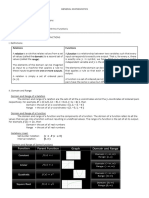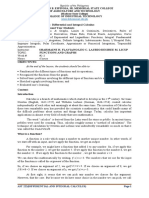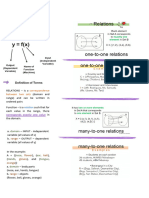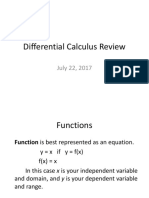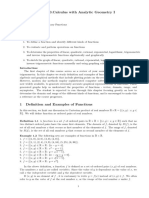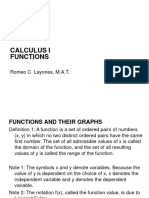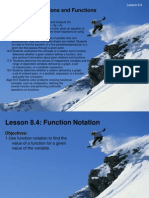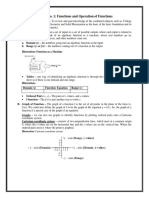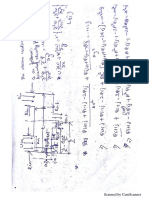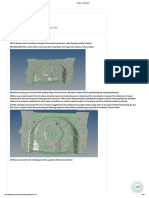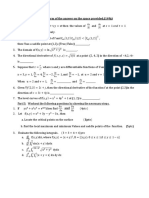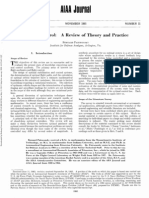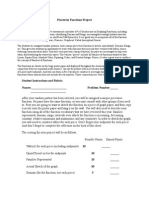CATsyllabus.
com
Functions
Definition
Suppose, if we take any system, the output will be a function of input. That means a function is a relation
between input and output.
For Example, there is a system, which finds the square of the given input. That means the output is a square
of the given input.
This can be represented by output= (input) 2
Or f(x) = x2. Where x is input and f(x) is out put. Here f is called the function of x, which is defined as
f(x) = x2.
So, if f(x) = x 2 , f(1) = 12 = 1, and f(2) = 22 = 4.
In general, if f(x) = x2, f(a) = a2.
Ex.1 (a) If f(x) = 2x2 2x + 1, find f( 1).
(b) If f(t) = 3t 1, find f(a2)
Sol. (a) We substitute 1 in place of x.
f( 1) = 2( 1)2 2 ( 1) + 1 = 5
(b) We substitute a2 in place t.
f(a2) = 3(a2) 1 = 3a2 1.
Odd and Even Functions
Odd function:
A function f is said to be odd if it changes sign when the sign of the variable is changed. i.e. If f( x) = f (x).
For example: f (x) = sin x ; 0 x 2 is a odd function.
Even function:
A function f is said to be an even function if it doesnt change sign when the sign of the variable is changed.
4 2
i.e. if f( x) = f (x).For example f (x) = x + x and g (x) = cos x are even functions.
NOTE: There are many functions which are neither odd nor even i.e it is not nessesary for a function to
be either even of to be odd. E.g: g (x) = 3x3 + 4x2 9 is a function in x which is neither even nor
odd.
Composite Functions
A composite function is the function of another function. If f is a function from A in to B and g is a function from
B in to C, then their composite function denoted by ( g o f) is a function from A in to C defined by
(g o f) (x) = g [ f(x)]
A B g C
f
x f(x)
g f(x)
e.g. if f(x) = 2x, and g(x) = x + 2, Then gof
(gof)(x) = g [ f(x)] = g (2x) = 2x + 2
(fog)(x) = f [ g(x)] = f(x + 2) = 2(x + 2) = 2x + 4
FACT : This shows that it is not nessesary that (fog)(x) = (g of)(x).
CATsyllabus.com
�Ex.2 Let a function fn + 1 (x ) = fn (x ) + 3 . If f2(2) = 4. Find the value of f6(2).
Sol. We have, fn + 1 (x ) = fn (x ) + 3
So, f3(2) = f2(2) + 3 = 7
f4(2) = f3(2) + 3 = 10
f5(2) = f4(2) + 3 = 13
f6(2) = f5(2) + 3 = 16
Alternate Method:
Since the function is increasing with constant value.
So, f6(2) = = f2(2) + 3( 6 2) = 4 + 12 = 16
Graphs of some special functions
TYPES OF FUNCTIONS GRAPHS
Constant Function y
f(x) = k
k f(x) = k
Domain: R x x
Range: k
y
Modulus Function y
f(x) = x or f(x) = x when x < 0
f(x) = k
x when x 0
x x
Domain: R o
Range: R+
y
Identity function
y
(2, 1)
f(x) = x
x x
Domain: R o
Range: R
CATsyllabus.com
� Greatest Integer Function or y
Step Function 3
2
f(x) = [x]
x 1 x
Domain: R
-3 -2 -1 1 2 3
Range: Integer -1
-2
Reciprocal function
y
1
f(x) =
x
f(x) = 1/x
Domain: R {0}
x
Range: R {0}
x
,0
2
Important: If f and g are two functions defined from set A in to set B, then
1. Sum / difference of two functions is ( f + g ) (x) = f(x) + g (x)
2. Product of two functions is ( f g) (x) = f(x) g (x)
f
3. Division of two functions is ,0 ( x ) = .
2 g
Inverse of an Element
Let us understand this with the help of an Example.
2
Ex.3 Find the inverse of y = and determine whether the inverse is also a function.
x5
Sol. Since the variable is in the denominator, this is a rational function. Here's the algebra:
2
Step 1: Write the original function y =
x5
5y 2
Step 2: Represent x in terms of y in the equation. x =
y
5x 2
Step 3: Replace the x's and y's with each other. y =
x
5x 2
Thus the inverse function is y = .
x
Iterative Functions
Just like the composite functions in which we perform the function g on f (x), if we perform the function f on f
(x) and continue performing the resulted function on f (x), n number of times. These types of functions are
called Iterative Functions.
For example: ( )
If f1(x) = 3x -1 and f n (x ) = f 1 f n 1(x ) for all n > 1.
Here f 5 (x ) = f (f (x )) = f [f (f (x ))] = f [f (f (f (x )))] = f [f [f (f (f (x )))]
1 4 1 1 3 1 1 1 2 1 1 1 1 1
CATsyllabus.com
� [ [ ( ( ))] but f
So, f 5 (1) = f 1 f 1 f 1 f 1 f 1(1) 1
(1) = 3 x 1 1 = 2
f (x) = f [ f { f (f {2))}] = f [ f { f (5)}] = f1 [ f1(14)] = f1(41) = 122
5 1 1 1 1 1 1 1
Transformations of Functions
We will examine four classes of transformations:
Horizontal translation: g(x) = f(x + c).
The graph is translated c units to the left if c > 0 and c units to the right if c < 0.
y = x2 y = (x + 1)2 y = (x 1)2
Vertical translation: g(x) = f(x) + k.
The graph is translated k units upward if k > 0 and k units downward if k < 0.
The graph is translated k units upward if k > 0 and k units downward if k < 0.
y = x2 y = x2 + 1 y = x2 1
Change of scale: g(x) = f(Ax).
The graph is compressed if |A| >1 and stretched out if |A| > 1. In addition, if A < 0 the graph is reflected about
the y-axis.
y = x2 y = (2x)2
CATsyllabus.com
�Change of amplitude: g(x) = Af(x).
The amplitude of the graph is increased by a factor of A if |A| > 1 and decreased by a factor of A if |A| < 1 In
addition, if A < 0 the graph is inverted.
y = f(x) y = 2f(x) y = 1/2f(x)
Solved Examples
Ex.4 If f(x) = 2x2 3, then f(2) = ?
Sol. f(2) = 2(2)2 3 = 5
2x 3 k
Ex.5 f(x) = if f(2) + f(3) = f(5), then K =
x+2
2(2) 3 k 2(3) 3 k
Sol. f(2) + f(3) = +
2+2 3+2
16 k 54 k
= +
4 5
250 k
And f(5) =
7
296 9k 250 k
=
20 7
2928
k=
43
Ex.6 f (n + 1) = 2f (n) + 4 & f(1) = 0. Then f (5) =
Sol. f(2) = 2f(1) + 4 = 0 + 4 = 4
f(3) = 2 4 + 4 = 12
f(4) = 2 12 + 4 = 28
f(5) = 2 28 + 4 = 60
CATsyllabus.com
�Ex.7 f(x) = x + 5, g(x) = x2 3. Then gofog(3) is :
Sol gofog(3) = gof(32 3) = gof(6) = g(6 + 5)
= g(11) = 112 3 = 118.
Ex.8 f(x) = 3x2 2x + 4 then f(1) + f(2) + - - - - + f(20) =
Sol. = 3(202) 2(20) + 4(20)
20 21 41 2 20 21
=3 + 80
6 2
= 8610 420 + 80 = 8270
Ex.9 f(x, y) = xy + yx. what can be the value of a + b, if f(a, b) = 17, a & b are integers
Sol. f(a, b) = ab + ba = 17
2 & 3 satisfy this (23 + 32 = 17)
a+b=5
{
Ex.10 f(x) = x + 1, g(x) = 5x -1. fn (x) = f f n1 (x ) }
n
and g (x) g g { n1
} 2 2
( x ) . If gof (k) = fog (k), find k?
2
Sol. gof (k) = gof(k + 1) = g(k + 2) = 5k + 9
& fog2 (k) = fog(5k 1) = f(25k 6) = 25 k 5
5k + 9 = 25k 5
14 7
k= =
20 10
1
Ex.11 g(x) = . What is the min possible value of n such that
x
g (n) g (n + 1) < 0.02
1 1
Sol. < 0.02
n n+1
1 1
<
n(n + 1) 50
n(n+1) > 50 . So, n should be 7 at least.
CATsyllabus.com
�Derivatives
Increment
When a variable changes from one value to another, the difference between the new value and the initial
value is called an increment.
If the initial value of a variable quantity says x is 9 and it changes to 9.2, the .2 is increment of x. But if x
changes from value 9 to 8.9 then increment may be either positive of negative according as the variable
increases or decreases during the change.
In general, remember that derivative of a function basically is a measure of the rate of change the function
with respect to another function.
dy
The notation for derivative is or f(x).
dx
Standard Results
Sr no Function Differentiation(dy/dx)
dy
1 y = xn = nxn-1
dx
dy
=e
x
2 y = ex
dx
dy 1
3 y = log x =
dx x
dy
4 y = ax = ax log a
dx
dy
5 y = sin x = cos x
dx
dy
6 y = cos x = sin x
dx
dy
7 y = tan x = sec2 x
dx
CATsyllabus.com
�Fundamental Theorems
Some important fundamental theorems are:
Theorem 1: The differential co-efficient of a constant is zero.
d d
For example: () = 0; (c) = 0.
dx dx
d
(K) = 0.
dx
Theorem 2: If u is a function of x and c is a constant then
d d
(u + c) = (u).
dx dx
d d d
For example: (3x2 5) = (3x2) (5) = 6x + 0 = 6x
dx dx dx
d d d
And; (2x k) = (2x) (k) = 2 0 = 2.
dx dx dx
Theorem 3: If u is a function of x and c is a constant, then
d du
(cu) = c
dx dx
d
For example: 3x4 = 3.4x4 1 = 12x3.
dx
d 2 2 2 1 2 1
1 1
1 1
x = . x = =
dx 5 5 2 5 x 1
5x 2
Theorem 4: If u, v, w, are functions of x, then
d d d d
(u v w + ) = (u) (v) (w)
dx dx dx dx
Simple Problems
1. Differentiate the following functions w. r. t. x
2
1
(a) x
x
x 4 + x 3 2x 2 4 x + 6
(b)
x2
2 4 12
Answer: (a) 2x (b) 2x + 1 + 3
x3 x 2
x
CATsyllabus.com
� Toolkit
PRODUCT RULE
d dv du
If u and v are the functions of x, then (uv) = u +v
dx dx dx
QUOTIENT RULE
If u and v are functions of x, then
du dv
v. u
d u dx dx
=
dx v v2
d u (Denom. Diff . co. eff . of Num.) (Num Diff . co eff . of Denom.)
=
dx v (Denom.) 2
x6
Ex.1 Differentiate x4 directly, taking as and x3 x; and show that result is the same.
x2
Sol. Let y = x4
dy
(i) = 4x3
dx
x6
(ii) y = x4 =
x2
d 6 d 2
x2 (x ) x 6 (x )
dy dx dx x 2 6 x 5 x 6 2x
= =
dx 2 2
(x ) x4
6 x 7 2x 7 4x 7 3
= 4
= 4
= 4x .
x x
4 3
(iii) y=x =x x
dy d (x) d (x 3 )
= x3 +x = x3 1 + x 3x2 = x3 + 3x3 = 4x3
dx dx dx
Hence the result is same in each case.
Differentiation of a function of a function
Consider y = u2 + 7u + 5, and u = x + 3.
y is a function of u and u is a function of x.
In such a case y is said to be function of a function.
If y = f (u) and u = g (x), then
dy dy du
= .
dx du dx
CATsyllabus.com
�Applications of the Derivative
DISTANCE & SPEED
If S denotes the distance travelled by a particle and
if S = at3 + bt2 + ct + d,
dS
Speed =
dt
Speed is the rate of change of Distance (S).
d2S
Acceleration =
dt 2
Acceleration is the rate of change of Speed
Ex.2 If S = 3t3 + 5t2 7t + 3 (S in cm & t in seconds), find velocity & acceleration at t = 3 sec.
dS
Sol. We have = 9t2 + 10t 7 = v
dt
dS
= v = 9 32 + 10 3 7 (at t = 3) = 81 + 30 7 = 81 + 23 = 104 cm/sec.
dt
d2S
and a = = 18 t + 10 = 18 3 + 10 = 64 cm/sec2 at t = 3.
dt 2
MARGINAL COST
We have Marginal Cost = Derivative of total cost w.r.t. the quantity
Average cost = Total cost / Total quantity
Ex.3 If the average cost is denoted by A = 3X2+ 9X 3, find marginal cost when output is 2 units.
Sol. We have Total cost = X A (X = quantity)
dC
C = 3X3 + 9X2 3X & Marginal Cost = = 9X2 + 18X 3
dX
At X = 2, Marginal Cost = 36 + 36 3 = 69.
CATsyllabus.com
�Slope of a line (m)
Slope of a line which is often denoted by m is equal to the tangent of the angle that it makes with x-axis.
A Y B
X X
A
B
If AB is the line making an angle with x-axis then, m = tan . As tan 90o can not be defined hence slope of a
vertical line | | to Y axis can not be defined.
dy
Geometrically it is denoted as .
dx
SLOPE OF THE TANGENT
If Y = f(X) is the equation of any curve, then the slope of tangent to this
curve at any point is the derivative of the equation of the curve at that
point.
Ex.4 If Y = X3 + 2X2 + 1 is the equation of the curve, find the slope of the tangent to the curve at the
point for which X = 1.
Sol. We have Y = 13 + 2 12 + 1 = 4 at X = 1. So the point is (1, 4).
dY
Now slope = = 3X2 + 4X + 0 = 7 at X = 1.
dX
MAXIMUM & MINIMUM VALUES OF A FUNCTION
If Y = f(X) is a function of X, then the function will assume different values for different values
of X.
dY
The value of Y = f(X) will be maximum or minimum when =0
dX
Working Rule for finding maximum and minimum values of a function
Step 1: Put the function y = f (x)
CATsyllabus.com
� dy
Step 2: Find and equate it to zero.
dx
dy
Solve the equation = 0, for real values and let x = a, b, c be its roots.
dx
d2 y
Step 3: Find . Put x = a, b, c in it one by one.
dx 2
d2 y
If is ve when x = a, then f (x) is maximum at x = a and the corresponding maximum value f
dx 2
(x) is f (a).
d2 y
If is + ve when x = a, then f (x) is minimum at x = a and the corresponding minimum value of
dx 2
f (x) is f(a).
.
Ex.5 Investigate for maxima & minima and thus find the maximum & minimum values of the function
F(X) = 41 + 24x 18x2.
Sol. F(x) = 41 + 24x 18x2.
d F( x ) d2F ( x )
= 24 36x and = 36.
dx dx 2
dF( x )
For maximum or minimum, =0
dx
2
24 36x = 0 x = .
3
d2F ( x )
Now, = 36 < 0.
dx 2
x = 2 / 3
2
F(x) is maximum when x = .
3
2
Maximum value of F (x) at x = ,
3
2
2 2
Which is equal to 41 + 24 x 18 = 49.
3 3
Practical Problems
The method to find the maxima and minima is very much helpful in Algebra, geometry and business, and
some problems regarding this can be solved easily and can be applied very usefully as illustrated below.
CATsyllabus.com
�Ex.6 Divide 15 into two parts so that product of these two pars is maximum or minimum.
Sol. Total = 15
Let one part be = x. Other = 15 x Do you know?
Now y = (15 x) x = 15x x2
The area of a
dy
= 15 2x rectangle is maximum
dx
for a given perimeter;
dy
Equating = 0; we get, 15 2x = 0 it must be a square.
dx
15 d2 y
or x = and =2
2 dx 2
15
Hence the function has only maximum value and the point is at x =
2
15 15 15
Required value of x = and other part = 15 =
2 2 2
15 15
So required values are and and it has no minima.
2 2
Ex.7 If V denotes the volume & S the surface area of a sphere of radius r, find the rate of change of V
w.r.t S when r = 2cm.
dV
Sol. We have to find .
dS
dV
Now V = 4/3 r3 = 4/3 3r2 = 4r2
dr
dS
S = 4r2 = 4 2r = 8 r
dr
dV
dV dr 4r 2 r
Now = = =
dS dS 8r 2
dr
dV
At r = 2 cm, = 1.
dS
Business Problems
120
The cost C per km. of electric cable is given by C = + 600 x, where x is the cross section in
x
square cms. Find the cross section for which the cost is least and also find the least cost per km.
120
Sol. Given C = + 600 x
x
dC 120 d2C 240
= 2 + 600 and 2
= 3
dx x dx x
CATsyllabus.com
� dC
Equating = 0; we get,
dx
120 1
2
+ 600 = 0 or x =
x 5
ve value is rejected and taking + ve value,
1
we get x = [Cross section cant be ve]
5
1 d2 C
At x = ; = 240 ( 5 )3 = 1200 5 and is + ve
5 dx 2
It is point of minima.
1
Hence least cost per km. is = 120 5 + 600
5
= 120 5 + 120 5 = 240 5 .
CATsyllabus.com











